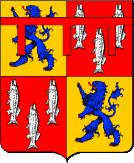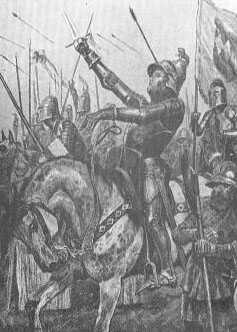Henry Percy (Hotspur)
| Sir Henry (Hotspur) Percy | |
|---|---|
_Percy%2C_Battle_of_Otterburn.jpg) The pennon of Sir Henry Percy captured by James Douglas, Earl of Douglas | |
| Spouse(s) | Elizabeth Mortimer |
|
Issue Henry Percy, 2nd Earl of NorthumberlandElizabeth Percy | |
| Noble family | House of Percy |
| Father | Henry Percy, 1st Earl of Northumberland |
| Mother | Margaret Neville |
| Born |
20 May 1364 Alnwick, Northumberland |
| Died |
21 July 1403 (aged 39) Shrewsbury, Shropshire |
Sir Henry Percy KG (20 May 1364 – 21 July 1403), commonly known as Sir Harry Hotspur, or simply Hotspur, was a late medieval English nobleman. He was known as one of the most valiant knights of his day, and was a significant captain during the Anglo-Scottish wars. He later led successive rebellions against Henry IV of England, and was slain at the Battle of Shrewsbury in 1403 at the height of his career.
Career

Henry Percy was born 20 May 1364 at Alnwick Castle in Northumberland, the eldest son of Henry Percy, 1st Earl of Northumberland, and Margaret Neville, daughter of Ralph de Neville, 2nd Lord Neville of Raby, and Alice de Audley.[1] He was knighted by King Edward III in April 1377.[2] In 1380 he was in Ireland with the Earl of March,[3] and in 1383 travelled in Prussia.[4] He was appointed warden of the east march either on 30 July 1384 or in May 1385,[4] and in 1385 accompanied Richard II on an expedition into Scotland.[1] 'As a tribute to his speed in advance and readiness to attack' on the Scottish borders, the Scots bestowed on him the name 'Haatspore'.[2] In April 1386 he was sent to France to reinforce the garrison at Calais, and led raids into Picardy. Between August and October 1387 he was in command of a naval force in an attempt to relieve the siege of Brest.[4] In appreciation of these military endeavours he was made a Knight of the Garter in 1388.[4] Reappointed as warden of the east march, he commanded the English forces against James Douglas, 2nd Earl of Douglas, at the Battle of Otterburn on 10 August 1388, where he was captured, but soon ransomed for a fee of 7000 marks.[2]
During the next few years Percy's reputation continued to grow. He was sent on a diplomatic mission to Cyprus in June 1393, and appointed deputy to John of Gaunt, 1st Duke of Lancaster, in the Duchy of Aquitaine.[2] He returned to England in January 1395, taking part in Richard II's expedition to Ireland, and was back in Aquitaine the following autumn. In the summer of 1396 he was again in Calais.[3]
His military and diplomatic service brought Percy substantial marks of royal favour in the form of grants and appointments,[4] but despite this the Percy family determined to support Henry Bolingbroke, the future Henry IV, on his return from exile in June 1399. Percy and his father joined Bolingbroke's forces at Doncaster, and marched south with them. After King Richard's deposition, Percy and his father were 'lavishly rewarded' with lands and offices.[3]
Under the new king, Percy had extensive civil and military responsibility in both the east march towards Scotland and in north Wales, where he was appointed High Sheriff of Flintshire in 1399. He was however under increasing pressure in north Wales as a result of the rebellion of Owain Glyn Dŵr. In March 1402 Henry IV appointed Percy royal lieutenant in north Wales, and on 14 September 1402 Percy, his father, and the Earl of Dunbar and March were victorious against a Scottish force at the Battle of Homildon Hill, taking prisoner among others Archibald Douglas, 4th Earl of Douglas.[1]
Rebellion and death

The Percys had become increasingly discontented with Henry IV, however. Among their grievances was the King's failure to pay the wages due to them for defending the Scottish border, his favour towards Dunbar, his demand that the Percys hand over their Scottish prisoners, his failure to put an end to Owain Glyn Dŵr's rebellion through a negotiated settlement, his increasing promotion of his son Prince Henry's military authority in Wales, and his failure to ransom the Percys' kinsman, Henry Percy's brother-in-law, Sir Edmund Mortimer (1376–1409), whom the Welsh had captured in June 1402, and who had a claim to the crown as the grandson of Lionel, Duke of Clarence, second surviving son of King Edward III.[5]
Spurred on by these grievances, in the summer of 1403 the Percys rebelled and took up arms against the King. According to Bean, it is clear that the Percys were in collusion with Glyndŵr. On his return to England shortly after the victory at Homildon Hill, Henry Percy issued proclamations in Cheshire accusing the King of 'tyrannical government'.[3] Joined by his uncle, Thomas Percy, Earl of Worcester, he marched to Shrewsbury where he intended to do battle against a force there under the command of the Prince of Wales. However the army of his father, Henry Percy, Earl of Northumberland was, for reasons never fully explained, slow to move south as well, and it was without Northumberland's assistance that Henry Percy and Worcester arrived at Shrewsbury on 21 July 1403, where they found the King with a large army. The ensuing battle was fierce, with heavy casualties on both sides, but when Henry Percy himself was struck down and killed, his own forces fled.[3] The Earl of Worcester was executed two days later.[6]
Prince Henry, upon being brought Percy's body after the battle, is said to have wept. The body was taken by Thomas Neville, 5th Baron Furnivall (d.1407), to Whitchurch, Shropshire for burial; however when rumours circulated that Percy was still alive, the King 'had the corpse exhumed and displayed it, propped upright between two millstones, in the market place at Shrewsbury'.[3] That done, the King dispatched Percy's head to York, where it was impaled on one of the city's gates; his four quarters were sent to London, Newcastle upon Tyne, Bristol, and Chester before they were finally delivered to his widow. She had him buried in York Minster in November of that year.[7] In January 1404, Percy was posthumously declared a traitor, and his lands were forfeited to the Crown.[citation needed]
Marriage and issue
Henry Percy married Elizabeth Mortimer, the eldest daughter of Edmund Mortimer, 3rd Earl of March, and his wife, Philippa, the only child of Lionel, 1st Duke of Clarence, and Elizabeth de Burgh, Countess of Ulster,[8] and by her had two children:
- Henry Percy, 2nd Earl of Northumberland (3 February 1393 – 22 May 1455), who married Eleanor Neville, by whom he had issue. He was slain at the First Battle of St Albans during the Wars of the Roses.[9]
- Elizabeth Percy (c.1395 – 26 October 1436), who married firstly John Clifford, 7th Baron de Clifford, slain at the Siege of Meaux on 13 March 1422, by whom she had issue, and secondly Ralph Neville, 2nd Earl of Westmorland (d. 3 November 1484), by whom she had a son, Sir John Neville.[10]
Sometime after 3 June 1406 Elizabeth Mortimer married as her second husband, Thomas de Camoys, 1st Baron Camoys, by whom she had a son, Sir Roger Camoys.[11] Thomas Camoys distinguished himself as a soldier in command of the rearguard of the English army at the Battle of Agincourt on 25 October 1415.[12]
Shakespeare and Henry Percy

Henry Percy, 'Hotspur', is one of Shakespeare's best-known characters. In Henry IV, Part 1 Percy is portrayed as the same age as his rival, Prince Hal, by whom he is slain in single combat. In fact he was 23 years older than Prince Hal, the future King Henry V, who was a youth of 16 at the date of the Battle of Shrewsbury.
| Wikimedia Commons has media related to Henry Percy. |
Footnotes
- ↑ 1.0 1.1 1.2 Richardson III 2011, p. 341; Walker 2004.
- ↑ 2.0 2.1 2.2 2.3 Richardson III 2011, p. 341; Cokayne 1936, p. 713; Walker 2004.
- ↑ 3.0 3.1 3.2 3.3 3.4 3.5 Walker 2004.
- ↑ 4.0 4.1 4.2 4.3 4.4 Cokayne 1936, p. 713; Walker 2004.
- ↑ Walker 2004; Pugh 1988, pp. 14, 37; Richardson III 2011, pp. 193–195; Holmes 2004; Tout 2004; Bean 2004.
- ↑ Bean 2004.
- ↑ Cokayne 1936, p. 714.
- ↑ Richardson III 2011, p. 341.
- ↑ Richardson III 2011, pp. 343–344.
- ↑ Richardson I 2011, p. 507; Richardson III 2011, p. 250.
- ↑ Cokayne 1912, p. 508; Richardson I 2011, pp. 398–399.
- ↑ Leland 2004.
References
- Bean, J.M.W. (2004). Percy, Henry, first earl of Northumberland (1341–1408). Oxford Dictionary of National Biography. Retrieved 3 October 2012.(subscription required)
- Cokayne, George Edward (1912). The Complete Peerage, edited by H.A. Doubleday II. London: St. Catherine Press. pp. 506–510.
- Cokayne, George Edward (1936). The Complete Peerage, edited by H.A. Doubleday IX. London: St. Catherine Press. pp. 713–714.
- Holmes, George (2004). Mortimer, Edmund (III), third earl of March and earl of Ulster (1352–1381). Oxford Dictionary of National Biography. Retrieved 29 September 2012.
- Leland, John L. (2004). Camoys, Thomas, Baron Camoys (c.1350–1420/21). Oxford Dictionary of National Biography. Retrieved 26 September 2012. (subscription required)
- Pugh, T.B. (1988). Henry V and the Southampton Plot of 1415. Alan Sutton. ISBN 0-86299-541-8
- Richardson, Douglas (2011). Magna Carta Ancestry: A Study in Colonial and Medieval Families, ed. Kimball G. Everingham I (2nd ed.). Salt Lake City. ISBN 1-4499-6637-3
- Richardson, Douglas (2011). Magna Carta Ancestry: A Study in Colonial and Medieval Families, ed. Kimball G. Everingham III (2nd ed.). Salt Lake City. ISBN 1-4499-6639-X
- Tout, T.F., rev. R.R. Davies (2004). Mortimer, Sir Edmund (IV) (1376–1408/9). Oxford Dictionary of National Biography. Retrieved 29 September 2012.
- Walker, Simon (2004). Percy, Sir Henry (1364–1403). Oxford Dictionary of National Biography. Retrieved 29 September 2012.
External links
- Percy, Charles. "The Ancient House of Percy".
- For an account of the Battle of Shrewsbury and Henry Percy's death see "Plantagenet Of Lancaster". English Monarchs.
- Statue of Henry Percy, 'Hotspur':
- "Alnwick". fickr.
- "Harry reborn in bronze". Northumberland Gazette. 22 July 2010.
- For fictional treatments see:
- Rose, Alexander. "Kings in the North". alexrose.com.
- Donsbach, Margaret. "A Bloody Field by Shrewsbury by Edith Pargeter". historicalnovels.info.
Ancestry
| Ancestors of Henry Percy (Hotspur) | |||||||||||||||||||||||||||||||||||||||||||||||||||||||||||||||||||||||||||||||||||||||||||||||||||||||||||||||||||||||||||||||||||||||||||||||||||||||||||||||||||||||||||||||||||||||||||||||||||||||||||||||||||||||||||||||||||||||||||||||||||||||||||||||||||||||||||||||||||||||||||||||||||||||||||||||||||||||||||||||||||||||||||||||||||||||||||||||||||||||||||||||||||||||||||||||||||||||||||||||||||||||||||||||||||||||||||||||||||||||||||||||||||||||||||||||||||||||||||||||||||||||||||||||||||||||||||||||||
|---|---|---|---|---|---|---|---|---|---|---|---|---|---|---|---|---|---|---|---|---|---|---|---|---|---|---|---|---|---|---|---|---|---|---|---|---|---|---|---|---|---|---|---|---|---|---|---|---|---|---|---|---|---|---|---|---|---|---|---|---|---|---|---|---|---|---|---|---|---|---|---|---|---|---|---|---|---|---|---|---|---|---|---|---|---|---|---|---|---|---|---|---|---|---|---|---|---|---|---|---|---|---|---|---|---|---|---|---|---|---|---|---|---|---|---|---|---|---|---|---|---|---|---|---|---|---|---|---|---|---|---|---|---|---|---|---|---|---|---|---|---|---|---|---|---|---|---|---|---|---|---|---|---|---|---|---|---|---|---|---|---|---|---|---|---|---|---|---|---|---|---|---|---|---|---|---|---|---|---|---|---|---|---|---|---|---|---|---|---|---|---|---|---|---|---|---|---|---|---|---|---|---|---|---|---|---|---|---|---|---|---|---|---|---|---|---|---|---|---|---|---|---|---|---|---|---|---|---|---|---|---|---|---|---|---|---|---|---|---|---|---|---|---|---|---|---|---|---|---|---|---|---|---|---|---|---|---|---|---|---|---|---|---|---|---|---|---|---|---|---|---|---|---|---|---|---|---|---|---|---|---|---|---|---|---|---|---|---|---|---|---|---|---|---|---|---|---|---|---|---|---|---|---|---|---|---|---|---|---|---|---|---|---|---|---|---|---|---|---|---|---|---|---|---|---|---|---|---|---|---|---|---|---|---|---|---|---|---|---|---|---|---|---|---|---|---|---|---|---|---|---|---|---|---|---|---|---|---|---|---|---|---|---|---|---|---|---|---|---|---|---|---|---|---|---|---|---|---|---|---|---|---|---|---|---|---|---|---|---|---|---|---|---|---|---|---|---|---|---|---|---|---|---|---|---|---|---|---|---|---|---|---|---|---|---|---|---|---|---|---|---|---|---|---|---|---|---|---|---|---|---|---|---|---|---|---|---|---|---|---|---|---|---|---|---|---|---|---|---|---|---|---|---|---|---|---|---|---|---|---|---|---|---|---|---|---|---|---|---|---|---|---|---|---|---|---|---|---|---|---|---|---|---|---|---|---|---|---|---|---|---|---|---|---|---|---|---|---|---|---|---|---|---|---|---|---|---|---|---|---|---|---|---|
<td rowspan="2>
| |||||||||||||||||||||||||||||||||||||||||||||||||||||||||||||||||||||||||||||||||||||||||||||||||||||||||||||||||||||||||||||||||||||||||||||||||||||||||||||||||||||||||||||||||||||||||||||||||||||||||||||||||||||||||||||||||||||||||||||||||||||||||||||||||||||||||||||||||||||||||||||||||||||||||||||||||||||||||||||||||||||||||||||||||||||||||||||||||||||||||||||||||||||||||||||||||||||||||||||||||||||||||||||||||||||||||||||||||||||||||||||||||||||||||||||||||||||||||||||||||||||||||||||||||||||||||||||||||
|